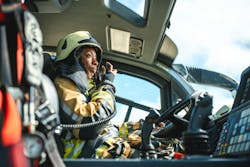Empowering First Responder Communications
This article originally appeared in the May 2024 issue of Security Business magazine. Don’t forget to mention Security Business magazine on LinkedIn and @SecBusinessMag on Twitter if you share it.
In the realm of emergency response, communication is not just a convenience, it is a lifeline. When crises strike, swift and accurate information exchange can mean the difference between safety and lives at risk, making uninterrupted communication protocols imperative. Recent mandates underscore the importance of ensuring continuous power for emergency communications systems, a critical development born from hard-learned lessons that leverage new technological advancements.
The catalyst for change came in the aftermath of the Sept. 11 attacks, which uncovered gaps in our emergency communication strategies. The 9/11 Commission Report highlighted communication breakdowns as a major factor in the response challenges faced by first responders. Factors such as compromised building infrastructure and radio signal limitations within high-rise structures underscored the need for innovative solutions to maintain communication continuity during emergencies.
In response to the shortcomings revealed on that fateful day, mandates were implemented to bolster emergency communication capabilities, particularly within high-rise buildings, in the hopes of empowering first responders to save lives and mitigate damage. New York City led the charge by requiring the installation of auxiliary radio communication systems (ARCS) in buildings exceeding 75 feet. These requirements, introduced in the 2014 NYC Building Code, marked a pivotal shift in emergency communication standards, setting a precedent for jurisdictions nationwide.
Seamless, Emergency Communications with ARCS
Conventional 700/800 MHz or UHF/VHF radio frequencies face significant challenges penetrating the various layers of building materials commonly encountered in high-rise structures – notably within stairwells, elevator shafts, and basements. In contrast, the meticulously engineered antenna system facilitated by an ARCS enables radio signals to effectively propagate throughout the interior of the building.
ARCS are a specialized form of emergency responder communications enhancement systems (ERCES), tailored to the unique challenges of urban environments like New York City.
ARCS are a specialized form of emergency responder communications enhancement systems (ERCES), tailored to the unique challenges of urban environments like New York City. Unlike conventional ERCES, ARCS provide dedicated radio channels for onsite command and control, enabling direct communication among first responders without relying on external dispatchers. These systems amplify radio signals bi-directionally from firefighters’ portable radios throughout building interiors, ensuring seamless communication during emergency operations.
Critical to the effectiveness of ARCS is their bi-directional and wireless capabilities, coupled with exclusive FDNY radio frequencies to prevent interference. Consisting of radio amplification units, antenna systems, and dedicated radio consoles, ARCS are precisely designed to penetrate the multiple layers of building materials found in high-rises, ensuring uninterrupted communication regardless of location within the structure.
Reliable power is paramount to the functionality of ARCS, especially during crises when communication is most critical and power is often threatened.
Powering Uninterrupted Emergency Communications
Reliable power is paramount to the functionality of ARCS, especially during crises when communication is most critical and power is often threatened. Advanced power backup solutions play a pivotal role in ensuring the uninterrupted operation of emergency communication systems, providing essential backup power for critical components such as radio amplification units. These solutions enhance system reliability and integrate remote monitoring capabilities for proactive maintenance and troubleshooting.
Annunciator panels play a vital role, synergizing with emergency ARCS backup power solutions. These panels can alert first responders, building management, and occupants when a fire or other emergency is imminent. Current annunciator panels feature multiple independent supervisory outputs for remote reporting of status and trouble conditions directly to the fire alarm control panel, facilitating quick response and intervention. This backup support is critical for public safety communication systems during power outages.
Overview of the UL 2524 In-Building Standard
The design and implementation of ERCES/ARCS components are governed by standards such as the National Fire Protection Association (NFPA 1225), with UL 2524 emerging as a recent pivotal standard for in-building emergency communications systems. UL 2524 certification signifies compliance with rigorous industry standards, guaranteeing seamless communication among emergency responders within commercial buildings. Compliance with UL 2524 is now a requirement for buildings to receive their certificate of occupancy, further underscoring its importance in ensuring the safety and security of occupants and first responders.
Bolstering Emergency Communications
In an increasingly interconnected world, resilient emergency communications are essential to preserving critical infrastructure and safeguarding lives. From natural disasters to unforeseen emergencies, reliable communication systems play a vital role in maintaining operational continuity across various sectors. Mandates for ERCES/ARCS reflect a collective commitment to bolstering emergency preparedness and response capabilities, ensuring that communication remains a steadfast ally in times of crisis.
The Washington Post in 2023 noted that the U.S. experienced an average of eight billion-dollar disasters annually for four decades, while in the last five years, that annual average skyrocketed to almost 18 annual events with total losses exceeding $100 billion. The recent Maui wildfires were plagued with emergency communications mishaps, with 101 lives lost, underscoring the importance of emergency communication mandates.
The ERCES and ARCS operational mandates for uninterrupted power in emergency communications systems represent a critical step towards enhancing emergency preparedness and response efforts for high-rise buildings and critical infrastructure. By prioritizing reliability and resilience in communication infrastructure, jurisdictions, and stakeholders alike reaffirm their commitment to safeguarding communities, one uninterrupted connection at a time.
Ronnie Pennington is Director of Sales for the Americas for Altronix Corporation. www.altronix.com * (718) 567-8181
About the Author

Ronnie Pennington
Ronnie Pennington is the national accounts manager for Altronix Corp., based in Brooklyn, N.Y.

